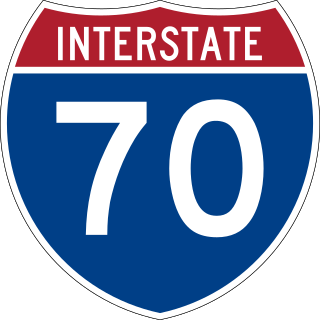
Interstate 70 (I-70) is a major east–west Interstate Highway in the United States that runs from I-15 near Cove Fort, Utah, to I-695 and Maryland Route 570 (MD 570) in Woodlawn, just outside Baltimore, Maryland. I-70 approximately traces the path of U.S. Route 40 east of the Rocky Mountains. West of the Rocky Mountains, the route of I-70 was derived from multiple sources. The Interstate runs through or near many major cities, including Denver, Topeka, Kansas City, St. Louis, Indianapolis, Columbus, Pittsburgh, and Baltimore. The sections of the Interstate in Missouri and Kansas have laid claim to be the first Interstate in the United States. The Federal Highway Administration (FHWA) has claimed the section of I-70 through Glenwood Canyon in Colorado, completed in 1992, to be the last piece of the Interstate Highway System, as originally planned, to open to traffic. The construction of I-70 in Colorado and Utah is considered an engineering marvel, as the route passes through the Eisenhower Tunnel, Glenwood Canyon, and the San Rafael Swell. The Eisenhower Tunnel is the highest point along the Interstate Highway System, with an elevation of 11,158 feet (3,401 m).

North Kansas City is a city in Clay County, Missouri, United States. It is also enclaved in Kansas City. Even though the name is similar to its larger counterpart, Kansas City, it is an independent municipality and part of the Kansas City metropolitan area. The population was 4,467 at the 2020 census. Originally a northern suburb across the Missouri River from Kansas City, it is now almost completely surrounded by Kansas City, which has annexed far to the north of North Kansas City's northern city limits. North Kansas City also adjoins the small municipality of Avondale.

The Manhattan Bridge is a suspension bridge that crosses the East River in New York City, connecting Lower Manhattan at Canal Street with Downtown Brooklyn at the Flatbush Avenue Extension. Designed by Leon Moisseiff and built by the Phoenix Bridge Company, the bridge has a total length of 6,855 ft (2,089 m). It is one of four toll-free vehicular bridges connecting Manhattan Island to Long Island; the nearby Brooklyn Bridge is just slightly farther west, while the Queensboro and Williamsburg bridges are to the north.

The Eads Bridge is a combined road and railway bridge over the Mississippi River connecting the cities of St. Louis, Missouri, and East St. Louis, Illinois. It is located on the St. Louis riverfront between Laclede's Landing to the north, and the grounds of the Gateway Arch to the south. The bridge is named for its designer and builder, James Buchanan Eads. Work on the bridge began in 1867, and it was completed in 1874. The Eads Bridge was the first bridge across the Mississippi south of the Missouri River. Earlier bridges were located north of the Missouri, where the Mississippi is smaller. None of the earlier bridges survive, which means that the Eads Bridge is also the oldest bridge on the river.

U.S. Route 169 is a north-south U.S highway that currently runs for 966 miles (1,555 km) from the city of Virginia, Minnesota, to Tulsa, Oklahoma, at Memorial Drive.
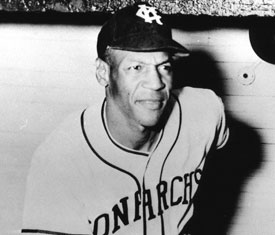
John Jordan "Buck" O'Neil Jr. was an American first baseman and manager in the Negro American League, mostly with the Kansas City Monarchs. After his playing days, he worked as a scout and became the first African American coach in Major League Baseball. In his later years he became a popular and renowned speaker and interview subject, helping to renew widespread interest in the Negro leagues, and played a major role in establishing the Negro Leagues Baseball Museum in Kansas City, Missouri. He was elected to the Baseball Hall of Fame in 2022 as an executive.

The Traffic Bridge is the name given to two truss bridges constructed across the South Saskatchewan River, connecting Victoria Avenue to 3rd Avenue South and Spadina Crescent in Saskatoon, Saskatchewan, Canada. The original bridge opened on October 10, 1907, and was the first bridge to carry motor vehicle traffic in Saskatoon, replacing an unreliable ferry service. The promised construction of the bridge was considered a prime factor in the amalgamation of the towns of Saskatoon, Nutana and Riversdale into one city named Saskatoon. The Traffic Bridge was the only road bridge in Saskatoon until 1916, when the University Bridge was completed. In 2010, the bridge was permanently closed due to severe corrosion and was demolished by 2016.
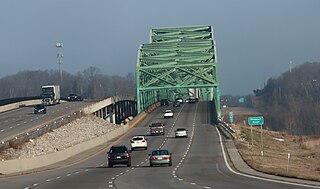
The Daniel Boone Bridge is the name for two bridges carrying Interstate 64, U.S. Route 40, U.S. Route 61 and the Avenue of the Saints across the Missouri River between St. Louis County and St. Charles County, Missouri. The older bridge, which carries westbound traffic, is a continuous truss bridge, while the newer bridge, which carries eastbound traffic, is a deck girder bridge.

The First Hannibal Bridge was the first permanent rail crossing of the Missouri River and helped establish the City of Kansas as a major city and rail center. In its early days it was called the Kansas City Bridge. It increased area train traffic, which contributed to the building of Union Depot, the predecessor to the Kansas City Union Station. It was severely damaged by a tornado and replaced in virtually the same location by the Second Hannibal Bridge.
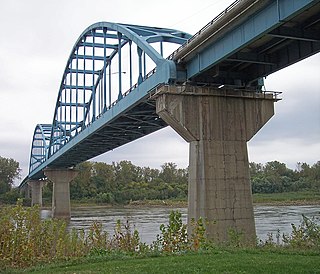
The Centennial Bridge is a through arch bridge road bridge over the Missouri River connecting Leavenworth, Kansas, and Platte County, Missouri. Constructed in 1955, it was initially a toll bridge. The bridge opened in 1955, a year after Leavenworth celebrated its centennial as the first city incorporated in Kansas. It is a two-span arch bridge connecting K-92 and Missouri Route 92. Its main span is 419.8 feet, and its total length is 2,571.2 feet. During the construction a spur of Route 45 called the "Leavenworth cutoff" was built to speed traffic to Kansas City, Missouri. The two-mile spur, even though it is in Missouri, was maintained by the city of Leavenworth until the tolls were removed from the Centennial Bridge in May 1977. The bridge is now maintained by the Kansas Department of Transportation.

The Fairfax Bridge and Platte Purchase Bridge were a pair of twin truss bridges over the Missouri River that handled traffic on U.S. Route 69 (US 69), connecting Interstate 635 (I-635) in Riverside, Missouri with the Seventh Street Trafficway in Fairfax, Kansas. The southbound span was built by the Kansas City Bridge Company, and was 2,486.5 feet (757.9 m) long and had 13 spans on 15 piers. The northbound spans biggest span was 465.96 feet and it is 2552.19 feet long and had a deck width of 28.31 feet and vertical clearance of 15.02 feet.
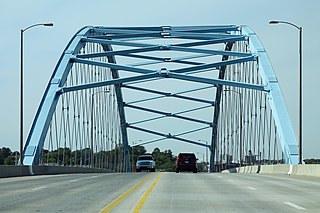
The Amelia Earhart Memorial Bridge is a network tied arch bridge over the Missouri River on U.S. Route 59 between Atchison, Kansas and Buchanan County, Missouri. It opened in December 2012, replacing a previous truss bridge with the same name.

The Second Hannibal Bridge is a rail bridge over the Missouri River in Kansas City, Missouri, connecting Jackson County, Missouri, with Clay County, Missouri.

Interstate 70 (I-70) in the US state of Missouri is generally parallel to the Missouri River. This section of the transcontinental Interstate begins at the Kansas state line on the Intercity Viaduct, running concurrently with US Route 24 (US 24), US 40, and US 169, and the east end is on the Stan Musial Veterans Memorial Bridge in St. Louis.

The Frederick Douglass–Susan B. Anthony Memorial Bridge is a triple steel arch bridge carrying Interstate 490 (I-490) over the Genesee River and New York State Route 383 in downtown Rochester, New York. The bridge, officially completed on June 18, 2007, replaced a 50-year-old multi-girder bridge situated in the same location.

The Intercity Viaduct are a pair of nine viaducts that cross the Kansas River in the United States. Designed by Waddell and Hedrick, the first viaduct, a four-lane, deck truss bridge, opened to the public on January 29, 1907, the second bridge, also of the deck truss design, opened to the public on November 12, 1962. It rises above the West Bottoms, and several sets of railroad tracks. The 1907 viaduct is notable for being the first roadway bridge to connect Kansas City, Missouri, with Kansas City, Kansas, non-stop all the way across. It is about 1.5 miles (2.4 km) long and carries Interstate 70/U.S. Route 24/U.S. Route 40/U.S. Route 169 (I-70/US 24/US 40/US 169).
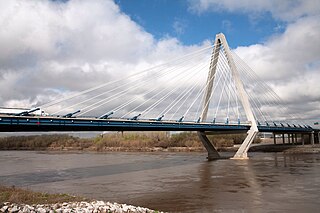
The Christopher S. Bond Bridge in Kansas City, Missouri is a cable-stayed bridge across the Missouri River. It carries I-29/I-35/US 71. The bridge opened to limited traffic on September 27, 2010, and all lanes opened on December 18, 2010. The Bond bridge is a replacement for the Paseo Bridge.

U.S. Route 169 is a U.S. Highway that travels from Tulsa, Oklahoma to Virginia, Minnesota. In the state of Missouri, US 169 enters the state from Kansas overlapped with I-70 / US 24 / US 40 at Kansas City and exits the state into Iowa north of Irena.
The Broadway Bridge is an arch bridge that spans the Arkansas River connecting the cities of Little Rock, Arkansas and North Little Rock, Arkansas. It carries U.S. Route 70 (US 70) and Arkansas Highway 365. The current bridge opened to traffic in March 2017. The original bridge was demolished in 2016. It was also an arch bridge and it opened in 1923.
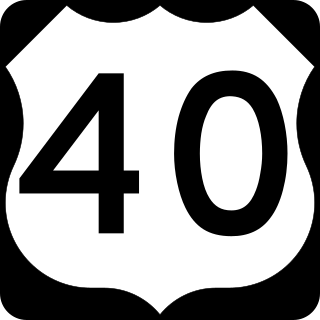
U.S. Route 40 (US 40) in the state of Missouri is a U.S. highway that runs from Kansas City to St. Louis. Outside of Greater St. Louis, much of the route either parallels or runs along I-70. East of Wentzville in Greater St. Louis, the route runs along I-64.



















